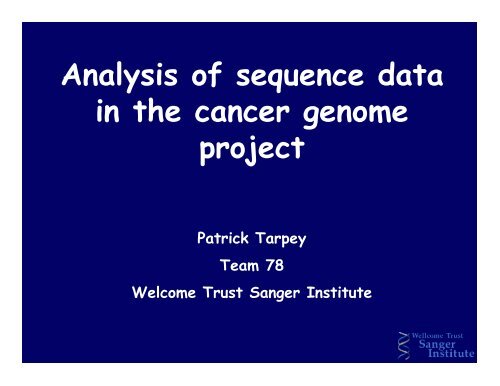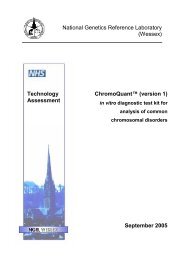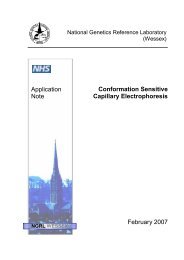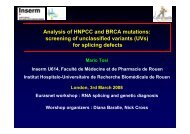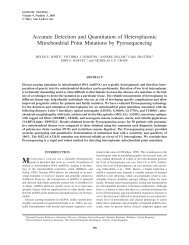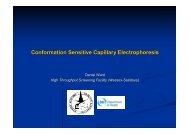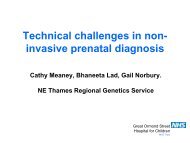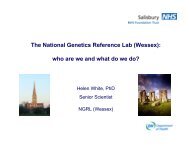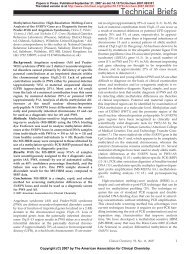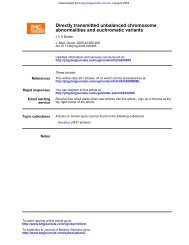Analysis of sequence data in the cancer genome project
Analysis of sequence data in the cancer genome project
Analysis of sequence data in the cancer genome project
You also want an ePaper? Increase the reach of your titles
YUMPU automatically turns print PDFs into web optimized ePapers that Google loves.
<strong>Analysis</strong> <strong>of</strong> <strong>sequence</strong> <strong>data</strong><br />
<strong>in</strong> <strong>the</strong> <strong>cancer</strong> <strong>genome</strong><br />
<strong>project</strong><br />
Patrick Tarpey<br />
Team 78<br />
Welcome Trust Sanger Institute
Use <strong>the</strong> human <strong>genome</strong> <strong>sequence</strong> and high throughput mutation<br />
detection techniques to identify somatically acquired <strong>sequence</strong><br />
variants/mutations and hence identify genes critical <strong>in</strong> <strong>the</strong><br />
development <strong>of</strong> human <strong>cancer</strong>s
Use <strong>the</strong> human <strong>genome</strong> <strong>sequence</strong> and high throughput mutation<br />
detection techniques to identify somatically acquired <strong>sequence</strong><br />
variants/mutations and hence identify genes critical <strong>in</strong> <strong>the</strong><br />
development <strong>of</strong> human <strong>cancer</strong>s<br />
The detection <strong>of</strong> large homozygous deletions provides<br />
<strong>in</strong>formation that may lead to <strong>the</strong> isolation <strong>of</strong> recessive<br />
oncogenes which have been <strong>in</strong>activated by <strong>the</strong> deletion.<br />
Small <strong>in</strong>tragenic mutations are commonly found <strong>in</strong> both<br />
recessive oncogenes and dom<strong>in</strong>antly act<strong>in</strong>g oncogenes This<br />
<strong>project</strong> is systematically screen<strong>in</strong>g cod<strong>in</strong>g exons and flank<strong>in</strong>g<br />
splice junctions <strong>of</strong> all genes <strong>in</strong> <strong>the</strong> human <strong>genome</strong> for somatically<br />
acquired small <strong>in</strong>tragenic mutations <strong>in</strong> human <strong>cancer</strong>
Use <strong>the</strong> human <strong>genome</strong> <strong>sequence</strong> and high throughput mutation<br />
detection techniques to identify somatically acquired <strong>sequence</strong><br />
variants/mutations and hence identify genes critical <strong>in</strong> <strong>the</strong><br />
development <strong>of</strong> human <strong>cancer</strong>s<br />
The detection <strong>of</strong> large homozygous deletions provides<br />
<strong>in</strong>formation that may lead to <strong>the</strong> isolation <strong>of</strong> recessive<br />
oncogenes which have been <strong>in</strong>activated by <strong>the</strong> deletion.<br />
Small <strong>in</strong>tragenic mutations are commonly found <strong>in</strong> both<br />
recessive oncogenes and dom<strong>in</strong>antly act<strong>in</strong>g oncogenes This<br />
<strong>project</strong> is systematically screen<strong>in</strong>g cod<strong>in</strong>g exons and flank<strong>in</strong>g<br />
splice junctions <strong>of</strong> all genes <strong>in</strong> <strong>the</strong> human <strong>genome</strong> for somatically<br />
acquired small <strong>in</strong>tragenic mutations <strong>in</strong> human <strong>cancer</strong><br />
X Project<br />
Genetics <strong>of</strong> learn<strong>in</strong>g Disability Aims to identify novel genes<br />
<strong>in</strong>volved <strong>in</strong> non-syndromic X-l<strong>in</strong>ked mental retardation
518 Genes<br />
10,000 STS’s<br />
CGP<br />
Set <strong>of</strong> Tumour<br />
samples and<br />
normals<br />
Colorectal<br />
PCR genes<br />
Re<strong>sequence</strong><br />
Normal<br />
<strong>Analysis</strong><br />
Tumour<br />
Somatic mutations<br />
Confirmation work
X <strong>project</strong>-candidate screen<br />
Candidate screen<br />
100 candidate<br />
genes<br />
~400 MR families<br />
2<br />
2<br />
.<br />
3<br />
2<br />
2<br />
2<br />
.<br />
3<br />
3<br />
2<br />
2<br />
.<br />
3<br />
1<br />
2<br />
2<br />
.<br />
2<br />
2<br />
2<br />
.<br />
1<br />
3<br />
2<br />
2<br />
.<br />
1<br />
2<br />
2<br />
2<br />
.<br />
1<br />
1<br />
2<br />
2<br />
.<br />
3<br />
2<br />
1<br />
.<br />
2<br />
2<br />
1<br />
.<br />
1<br />
1<br />
1<br />
.<br />
4<br />
1<br />
1<br />
.<br />
3<br />
1<br />
1<br />
.<br />
2<br />
3<br />
1<br />
1<br />
.<br />
2<br />
2<br />
1<br />
1<br />
.<br />
2<br />
1 1<br />
1<br />
.<br />
1<br />
1<br />
1<br />
.<br />
1<br />
1<br />
1<br />
.<br />
2<br />
1<br />
2<br />
1<br />
3<br />
.<br />
1<br />
1<br />
3<br />
.<br />
2<br />
1<br />
3<br />
.<br />
3<br />
2<br />
1<br />
.<br />
1<br />
2<br />
1<br />
.<br />
2<br />
2<br />
1<br />
.<br />
3<br />
1<br />
2<br />
1<br />
.<br />
3<br />
2<br />
2<br />
2<br />
.<br />
1<br />
2<br />
2<br />
.<br />
2 2 2<br />
.<br />
3<br />
2<br />
3<br />
2<br />
4<br />
2<br />
5<br />
2<br />
6<br />
.<br />
1<br />
2<br />
6<br />
.<br />
2<br />
2<br />
6<br />
.<br />
3<br />
2<br />
7<br />
.<br />
1<br />
2<br />
7<br />
.<br />
2<br />
2<br />
7<br />
.<br />
3<br />
2<br />
8
•High-throughput mutation detection<br />
•~80-100 000 PCR’s week<br />
•Somatic heterozygous mutations <strong>in</strong> tumours<br />
can be subtle<br />
•Insertions/deletions<br />
•Aneuploidies<br />
•Normal contam<strong>in</strong>ation
Mutation detection <strong>of</strong> small<br />
<strong>in</strong>tragenic variants<br />
Conformation sensitive capillary electrophoresis (CSCE)<br />
Cancer<br />
Blood<br />
CanPlot<br />
Normal<br />
SNP
Mutation detection <strong>of</strong> small<br />
<strong>in</strong>tragenic variants<br />
• Re-sequenc<strong>in</strong>g<br />
•More robust at high throughput (fewer fails)<br />
•Affordable<br />
•Quick<br />
•Automated <strong>data</strong> analysis<br />
•10 ABI 3730’s
PCR protocol<br />
F<br />
_____________________~500bp____________________<br />
R<br />
•Amplimers are a maximum <strong>of</strong> 500 bp (3730 rapid runs, 30<br />
m<strong>in</strong>)
PCR protocol<br />
__55bp__<br />
__55bp__<br />
•Amplimers have ~75bp ‘buffer Zone’ <strong>in</strong>clud<strong>in</strong>g primer
PCR protocol<br />
__55bp__<br />
__55bp__<br />
____Region <strong>of</strong> <strong>in</strong>terest Exon +/- 6bp____
PCR protocol<br />
__55bp__<br />
__55bp__<br />
____Region <strong>of</strong> <strong>in</strong>terest Exon +/- 6bp____<br />
PCR protocol<br />
Two temperatures<br />
S<strong>in</strong>gle buffer<br />
Purified<br />
ExoSAP<br />
Sequenc<strong>in</strong>g protocol<br />
BigDye (1/16 diln)<br />
Purification<br />
Ethanol ppt<br />
Resuspension<br />
Water
Data analysis<br />
BLAT<br />
In house (homozygous variants)<br />
Mutation Surveyor<br />
CSA<br />
In house development
BLAT<br />
•Phred basecalls AB1/SCF files<br />
•<br />
•Aligns to <strong>genome</strong><br />
•Identifies differences <strong>in</strong> basecall alignment<br />
•(assess quality us<strong>in</strong>g phred quality scores)<br />
•Restricts analysis to ROI and excludes known<br />
SNP’s<br />
•Compares identified variants <strong>in</strong> forward and<br />
reverse strands<br />
•Records coverage
BLAT<br />
Text output<br />
312 3972 r g,98,a,46129870 2_strands OPPOSITE HAS VARIANT<br />
312 3972 f g,170,a,46129870 2_strands OPPOSITE HAS VARIANT<br />
370 3977 f t,59,c,46131655 2_strands OPPOSITE HAS VARIANT<br />
370 3977 r t,190,c,46131655 2_strands OPPOSITE HAS VARIANT<br />
016 3972 f 1,94,-,46129796 1_strand<br />
314 3974 r c,169,a,46130381 1_strand<br />
050 3974 r c,166,a,46130381 1_strand
Advantages<br />
BLAT<br />
•Simultaneous analysis <strong>of</strong> multiple STS’s <strong>in</strong><br />
multiple samples<br />
•Rapid analysis<br />
•Few false positives<br />
•Inputs <strong>sequence</strong> files only
Disadvantages<br />
BLAT<br />
•Only detects homozygous variants<br />
•Trace verification <strong>of</strong> variants required
Mutation Surveyor
Mutation Surveyor
Mutation Surveyor
Mutation Surveyor<br />
• 5 Mutation parameters<br />
• Mutation height<br />
• Must exceed m<strong>in</strong>imum value<br />
• Overlapp<strong>in</strong>g factor<br />
• Detects presence <strong>of</strong> mutant peak<br />
• Dropp<strong>in</strong>g factor<br />
• Detects drop <strong>in</strong> height <strong>of</strong> wild type peak compared to<br />
reference peak (normalised with 2 upstream and 2<br />
downstream peaks)<br />
• SN-ratio<br />
• Signal: mutation peak <strong>in</strong>tensity<br />
• Noise: Median peak <strong>in</strong>tensity around mutant peak<br />
• Mutation score<br />
• Mutation error probability score<br />
• Noise/overlapp<strong>in</strong>g factor/dropp<strong>in</strong>g factor
Mutation Surveyor<br />
• Advantages<br />
Quick<br />
High-throughput<br />
Simple <strong>in</strong>terfaces<br />
Identifies variants <strong>in</strong> reference<br />
Electropherogram<br />
ROI<br />
Coverage
Mutation Surveyor<br />
• Disadvantages<br />
Sensitivity<br />
homozygous variants<br />
heterozygous <strong>in</strong>sdels<br />
Intensity <strong>in</strong>formation lost<br />
( Overloaded)<br />
Inflexible
Mutation Surveyor<br />
• Disadvantages<br />
Sensitivity<br />
homozygous variants<br />
heterozygous <strong>in</strong>sdels
DLG3, 1087<strong>in</strong>sC<br />
a<br />
exon 7<br />
C C TC A G G T TC C CCC CAC C CG<br />
Family 260<br />
841 GTGAACAACACCAATCTGCAGGATGTGAGGCACGAGGAAGCTGTGGCCTCACTGAAGAAC<br />
281 -V--N--N--T--N--L--Q--D--V--R--H--E--E--A--V--A--S--L--K--N-<br />
PDZ2<br />
wild-type<br />
exon 7<br />
C C TC AG G T TC C CCC CCACC CG<br />
901 ACATCTGATATGGTGTATTTGAAGGTGGCCAAGCCAGGCAGCCTCCACCTCAACGACATG<br />
301 -T--S--D--M--V--Y--L--K--V--A--K--P--G--S--L--H--L--N--D--M-<br />
7<br />
961 TACGCTCCCCCTGACTACGCCAGCACTTTTACTGCCTTGGCTGACAACCACATAAGCCAT<br />
321 -Y--A--P--P--D--Y--A--S--T--F--T--A--L--A--D--N--H--I--S--H-<br />
1021 AATTCCAGCCTGGGTTATCTCGGGGCTGTGGAGAGCAAGGTCAGCTACCCTGCTCCTCCT<br />
341 -N--S--S--L--G--Y--L--G--A--V--E--S--K--V--S--Y--P--A--P--P-<br />
1081 CAGGTTCCCCCCCACCCGCTACTCTCCTATTCCCAGGCACATGCTGGCTGAGGAGGACTTC<br />
361 -Q--V--P--P--H--P--L--L--S--Y--S--Q--A--H--A--G--X--E--D--F-<br />
8<br />
1141 ACCAGAGAGCCTCGCAAGATCATCCTGCACAAAGGCTCCACAGGCCTGGGCTTCAACATC<br />
381 -T--R--E--P--R--K--I--I--L--H--K--G--S--T--G--L--G--F--N--I-<br />
mutant
Mutation Surveyor
Mutation Surveyor
Mutation Surveyor
Homozygous mutations<br />
Mutation<br />
Sample No. STS Mutation Nucleotide am<strong>in</strong>o acid BLAT Surveyor<br />
312<br />
3972<br />
Missense<br />
A703>G<br />
N103>D<br />
a<br />
a<br />
370<br />
3977<br />
Splice<br />
-5C>T<br />
a<br />
a<br />
324 5103 Missense C1953>T T625>M a a<br />
385 3960 Frameshift 526delA a a<br />
134 5277 Frameshift 839<strong>in</strong>sA a x<br />
360 3963<br />
393 3964<br />
<strong>in</strong> frame deletion<br />
Missense<br />
921-923delTGA<br />
A1103>G<br />
175del D<br />
N236>S<br />
135 5258 Missense G1220>C G275>A a a<br />
a<br />
a<br />
x<br />
a<br />
72 4077<br />
<strong>in</strong> frame deletion<br />
454-456delGGA<br />
152delG<br />
a<br />
x<br />
327 4074<br />
Silent<br />
A214>G<br />
L21>L<br />
a<br />
a<br />
123 3600<br />
Missense<br />
T2767>C<br />
W914>R<br />
a<br />
a<br />
16 3584<br />
Missense<br />
T829>C<br />
Y268>H<br />
a<br />
a<br />
74 3596 Missense A2156>G<br />
D710>G<br />
a<br />
a
Del 3bp
<strong>in</strong>sA
Del 3bp
Development-CSA<br />
Comparative <strong>sequence</strong> analysis<br />
Comparative analysis <strong>of</strong> normalised peak heights <strong>in</strong> a sample trace<br />
compared to a reference trace<br />
<strong>Analysis</strong> performed on raw <strong>data</strong>
Auto-CSA (Excel)<br />
Automated-comparative <strong>sequence</strong> analysis<br />
•Use Genescan/Genemapper to identify and<br />
quantify peaks.<br />
•Use autoCSA to extract <strong>in</strong>formation for <strong>the</strong> real<br />
peaks and ignore noise peaks (us<strong>in</strong>g reference<br />
text)<br />
•Compare normalised peak heights between<br />
sample and reference.<br />
•If a normalised peak drops by >35%, Mutation<br />
(trace verify)
CSA
CSA
CSA
oncoCSA (Pearl/JAVA)<br />
•Use Genescan/Genemapper to identify and<br />
quantify peaks.<br />
•Use autoCSA to extract <strong>in</strong>formation for <strong>the</strong> real<br />
peaks and ignore noise peaks (us<strong>in</strong>g reference<br />
text)<br />
•Compare normalised peak heights between<br />
sample and reference.<br />
•If a normalised peak drops by >20%, Mutation<br />
(trace verify)
oncoCSA<br />
• Look for mutant peak (discrim<strong>in</strong>ate from noise)<br />
• Present variant trace (and reverse)<br />
• Apply a quality score for each base/trace (Q)<br />
• Comb<strong>in</strong>e forward and reverse <strong>in</strong>formation<br />
(reduce false positives, determ<strong>in</strong>e coverage)<br />
• Integrated Study management, track<strong>in</strong>g, analysis,<br />
annotation, archive
<strong>Analysis</strong> workflow<br />
Lab<br />
Reruns<br />
Files<br />
automatically<br />
moved <strong>of</strong>f ABI<br />
ABI<br />
3730<br />
Canpor<br />
SNP<br />
Visualisation/<br />
Verification<br />
Interfaces<br />
File Storage<br />
hotCSA<br />
Mobility corr<br />
autoCSA<br />
Quality, Coverage
Validation<br />
Competition set<br />
• Sensitivity <strong>of</strong> Substitution detection<br />
– Heterozygotes = 98% (4 not <strong>in</strong>terogated, missed 2)<br />
– Homozygotes = 100%<br />
– (<strong>data</strong> set <strong>of</strong> 7,733 comparisons compared aga<strong>in</strong>st<br />
Mutation surveyor)<br />
– CSA detected 3 additional mutations Surveyor<br />
missed
CSA development<br />
oncoCSA SUMMARY<br />
• CSA looks robust at high-throughput<br />
• Integrated sample management, track<strong>in</strong>g, analysis, annotation, archive<br />
Current development<br />
• Q scores maximise <strong>in</strong>formation retrieved from a trace<br />
• het <strong>in</strong>sdels<br />
Surveyor<br />
• Good for het po<strong>in</strong>t mutations<br />
• Not 100% sensitive<br />
• Controls<br />
• BLAST
Cancer Genome Project<br />
Mike Stratton<br />
Andy Futreal<br />
Richard Wooster<br />
Bamford, Sally,<br />
Barthorpe, Andrew<br />
Bignell, Graham<br />
Blow, Mat<strong>the</strong>w<br />
Brackenbury, Lisa<br />
Butler, Adam<br />
Chim, Anne<br />
Clarke, Oliver<br />
Clegg, Sheila<br />
Cole, Jennifer<br />
Davies, Helen<br />
Dawson, Elisabeth<br />
Dicks, Ed<br />
Dike, Angus<br />
Drozd, Anja<br />
Edk<strong>in</strong>s, Sarah<br />
Edwards, Ken<br />
Forbes, Simon<br />
Foster, Rebecca<br />
Gray, Kristian<br />
Greenman, Chris<br />
Halliday, Kelly<br />
Haynes, Wendy<br />
Hills, Katy<br />
Korny, Angelique<br />
Kosmidou, Vivienne<br />
Lugg, Richard<br />
Menzies, Andrew<br />
O'Meara, Sarah<br />
Parker, Adrian<br />
Perry, Janet<br />
Petty, Robert<br />
Ra<strong>in</strong>e, Keiran<br />
Ratford, Lewis<br />
Shepherd, Rebecca<br />
Small, Alexandra<br />
Smith Rafaella<br />
Stephens, Philip<br />
Stephens, Yvonne<br />
Stevens, Claire<br />
Tarpey, Patrick<br />
Teague, Jon<br />
T<strong>of</strong>ts, Calli<br />
Varian, Jennifer<br />
West, S<strong>of</strong>ie<br />
Widaa, Sara<br />
Yates, Andrew<br />
X <strong>project</strong><br />
Lucy Raymond<br />
Josep Parnau<br />
UK, Aus, USA, Europe Cl<strong>in</strong>icians<br />
CSA, Cambridge, Salisbury<br />
Chris Mattocks<br />
Jo Whittaker<br />
Mart<strong>in</strong> Bobrow


